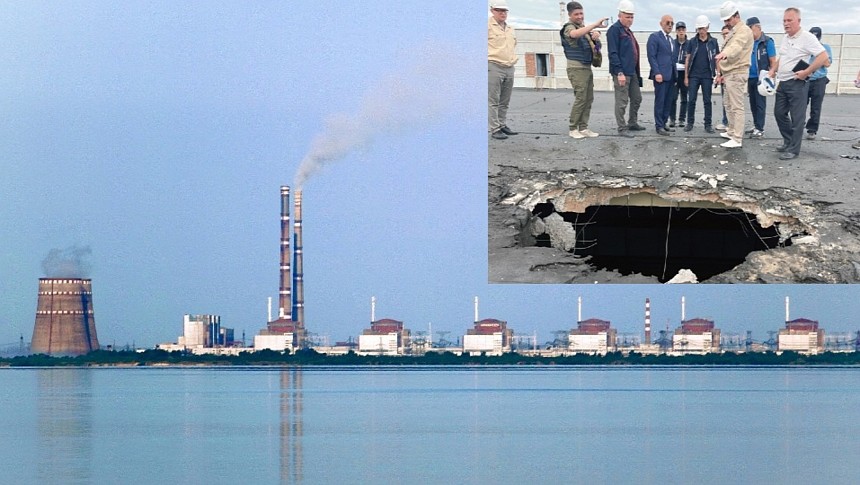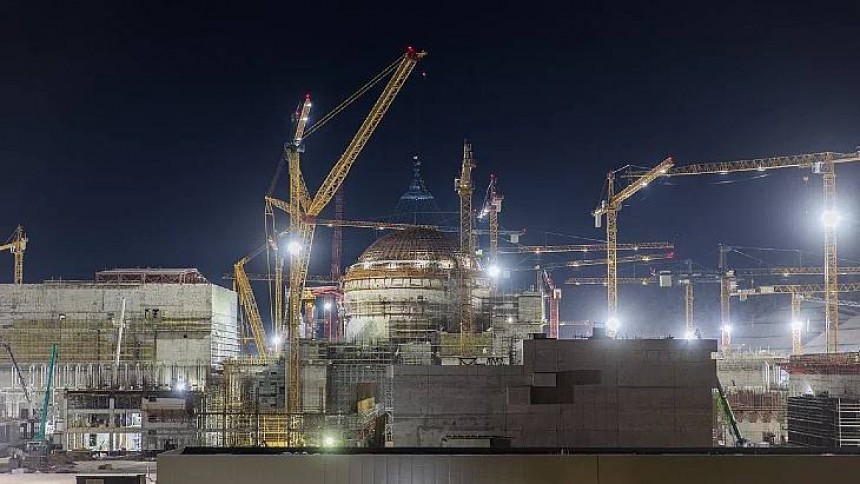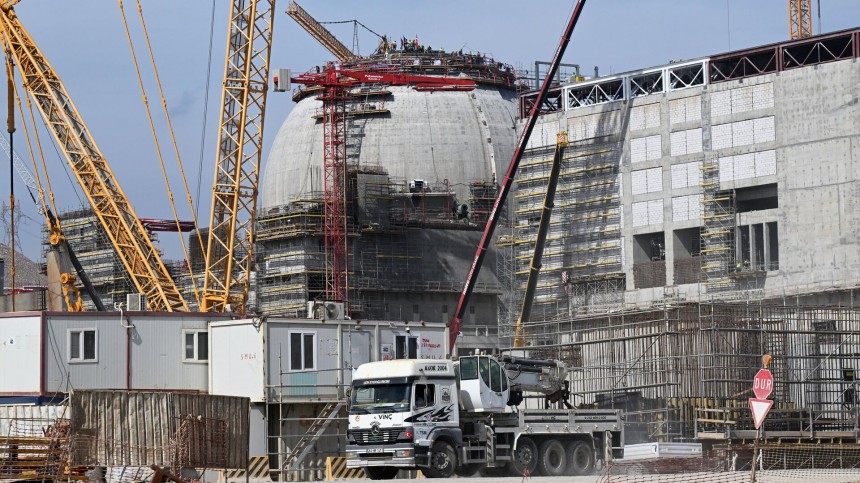When people conjure images of nuclear power plants, it's usually an image of Chornobyl (Chernobyl), Fukushima, Three Mile Island, and that's about pretty much where that list ends. But by the end of the 2020s, there's a good chance that another nuclear plant joins the shortlist that everyone, even non-energy sector-inclined people, knows by name. It just so happens to share land in the same country as Chornobyl. This is the story of the Zaporizhzhia Nuclear Power Plant (ZNPP). Europe's largest fission reactor that's under siege by an invading power.
In many ways, Chornobyl and Zaporizhzhia are two reactor facilities joined at the hip not only by country but a shared drive by Moscow and Kyiv to turn the then-Ukrainian SSR into an atomic titan. Oh, how terribly wrong things have gone since then. Whatever the case, Zaporizhzhia and Chornobyl may look visually similar. But don't be fooled; the two plants, located over 750 km (466 mi) apart from each other, couldn't be more different inside.
Less than three years after the RBMK-1000 class boiling-water reactor (BWR) was first commissioned at Chornobyl in 1977, and the state workers at the Zaporizhzhia plant began constructing its first reactor complex along the banks of the Dnieper River in April 1980. Under the leadership of Communist General Secretary Leonid Brezhnev, the plant was intended to give the Ukrainian SSR a similar energy-producing capability to the most populated regions in North America. Between itself and Chornobyl generated thousands of megawatts of both thermal energy, by association, useable turbine-generated energy.
While a lack of modern safety features plagued Chornobyl's RBMK 1000 BWRs and that nagging little devil called a high positive void coefficient, the Zaporizhzhia complex benefitted from an entirely different design principle. Typical boiling-water reactors like the RBMK-series, at their most basic principles, are nothing more than a fissile reactor core, usually made of any manner of uranium isotopes arranged in a cylinder-like formation made of fuel rods. When surrounded by a neutron-moderating material, typically graphite, to keep the reaction flowing at a more or less constant rate, distilled water is pumped directly through this fissile core while roof-mounted control rods are raised and lowered in sequence to control the reaction as needed.
The resulting steam is pumped to a turbine hall, and you now have a treasure trove of carbon-free energy. In the case of Chornobyl, a flagrant lack of regulations or ample safety features bit the Soviets in the rear end in more ways than one. But the six fission facilities that make up the ZNPP complex need not worry about silly things like positive void coefficient or excess levels of xenon in the reactor, thanks to using entirely different pressurized-water reactors (PWRs). Unlike BWRs that use typical ambient-pressure distilled water to generate steam, a PWR's high-strength reactor vessel pressurizes this water to such a high degree that molecules of water can't turn to steam or thermochemically split, as happened during the Chornobyl disaster.
When this pressurized water is directed towards a steam chamber pressurized to just one Earth atmosphere (101.325 kPa or 14.7 psi), the resulting ferocious thermal energy is enough to make contemporary BWRs of the day seem primitive. By September 1996, six Atomstroyexport VVER (Voda Voda Energo Reactor)- class reaction facilities had been commissioned at Zaporizhzhia. When all is said and done, that works out to 5,700 megawatts of useable electricity produced out of roughly 18,000 megawatts of thermal energy when the outputs of each reactor are combined.
Compared to the triple-reactor unit Palo Verde Nuclear Plant in Arizona, the most powerful in the United States, Zaporizhzhia generates roughly 1,700 megawatts more for its electrical grid. Only a select few reactor plants in Japan and South Korea outright beat the ZNPP in raw electricity output. This profound level of power generation made the Zaporizhzhia plant a prime target for the invading Russian Armed Forces. The day that Chornobyl became a strategic zone in the 2022 Russian Invasion of Ukraine on February 24th of that year was a dark yet ironic day in world history.
But as scary as such a scenario may seem, things took an even more somber tone the following month on March 3rd. On that day, at approximately 11:28 p.m. local time, a column of at least ten armored vehicles, most likely BMP-class Infantry Fighting vehicles and two T-95 tanks from a Russian battalion tactical group (BTG), approached the city of Enerhodar and the Zaporizhzhia plant from beyond the horizon. In the heavy shelling that ensued, it was decided by the state-owned Ukrainian energy firm Energoatom to succeed control of Zaporizhzhia to the Russian State-asset Rosatom to prevent further fighting from damaging the plant.
Coincidentally, Rosatom is also responsible as the main foreign contractor for Turkey's first commercial nuclear station, the Akkuyu Nuclear Power Plant (ANPP). Turkey, of course, is a stalwart nation in the NATO alliance. Twisted priorities aside, Ukranian engineers continued to operate the Zaporizhzhia plant while staff gradually shut down each reactor building. All six units were shut down by September 11th, 2022. Nineteen days later, the annexation of the entire Ukrainian Zaporizhzhia Oblast had already been declared alongside the Oblasts of Donetsk, Kherson, and Luhansk.
Invitations by the Russian Federation to have the International Atomic Energy Agency's Director General Rafael Grossi visit the plant on September 1st, 2022 did little to quell fears of a potential significant nuclear accident somewhere down the line of the fighting and shelling at and around the facility wasn't neutralized. Russian forces detained key Ukrainian engineers and higher-ups in the initial siege of the Zaporizhzhia plant did little to warm the IAEA's welcome. Since then, contingency plans inspired by learning what not to do at Chornobyl began being implemented in Ukrainian Oblasts in the direct path of radiation in the event of a meltdown.
Reserves of bottled water, Geiger counters, potassium iodide pills, and all the supplies needed to survive another Chornobyl have since begun distribution across these regions. With significant advances made by the Ukrainian Armed Forces during the spring of 2023 and a significant spring offensive to take back Russian-occupied territory expected any day, it's anyone's guess if a military engagement between Russia and Ukraine occurring right at the doorstep of another potential Chornobyl takes place or not. In the meantime, a report by Reuters on May 22nd revealed that Ukrainian engineers had restored power to the Zaporizhzhia plant, allowing it to connect to a battered national grid.
How this bodes for any potential fighting for control of the reactor could go several different ways. For one thing, don't be surprised if Ukrainian counter-offensives are hesitant to approach the Zaporizhzhia facility with large groups of infantry or armored vehicles. Given the consequences of a wayward tank shell, mortar, or guided missile in just the right spot on reactor grounds, it's logical to believe that Ukraine could resort to other methods like drone strikes or cyber-warfare to gain control of its prized energy plant. As for Russia, don't be surprised if they resort to something they've been known to do during the invasion and start digging trenches.
Whatever the case, the results for conditions at the reactor going south speak for themselves. One far scarier than any HBO Special about nuclear accidents could possibly make it out to be.
Less than three years after the RBMK-1000 class boiling-water reactor (BWR) was first commissioned at Chornobyl in 1977, and the state workers at the Zaporizhzhia plant began constructing its first reactor complex along the banks of the Dnieper River in April 1980. Under the leadership of Communist General Secretary Leonid Brezhnev, the plant was intended to give the Ukrainian SSR a similar energy-producing capability to the most populated regions in North America. Between itself and Chornobyl generated thousands of megawatts of both thermal energy, by association, useable turbine-generated energy.
While a lack of modern safety features plagued Chornobyl's RBMK 1000 BWRs and that nagging little devil called a high positive void coefficient, the Zaporizhzhia complex benefitted from an entirely different design principle. Typical boiling-water reactors like the RBMK-series, at their most basic principles, are nothing more than a fissile reactor core, usually made of any manner of uranium isotopes arranged in a cylinder-like formation made of fuel rods. When surrounded by a neutron-moderating material, typically graphite, to keep the reaction flowing at a more or less constant rate, distilled water is pumped directly through this fissile core while roof-mounted control rods are raised and lowered in sequence to control the reaction as needed.
The resulting steam is pumped to a turbine hall, and you now have a treasure trove of carbon-free energy. In the case of Chornobyl, a flagrant lack of regulations or ample safety features bit the Soviets in the rear end in more ways than one. But the six fission facilities that make up the ZNPP complex need not worry about silly things like positive void coefficient or excess levels of xenon in the reactor, thanks to using entirely different pressurized-water reactors (PWRs). Unlike BWRs that use typical ambient-pressure distilled water to generate steam, a PWR's high-strength reactor vessel pressurizes this water to such a high degree that molecules of water can't turn to steam or thermochemically split, as happened during the Chornobyl disaster.
Compared to the triple-reactor unit Palo Verde Nuclear Plant in Arizona, the most powerful in the United States, Zaporizhzhia generates roughly 1,700 megawatts more for its electrical grid. Only a select few reactor plants in Japan and South Korea outright beat the ZNPP in raw electricity output. This profound level of power generation made the Zaporizhzhia plant a prime target for the invading Russian Armed Forces. The day that Chornobyl became a strategic zone in the 2022 Russian Invasion of Ukraine on February 24th of that year was a dark yet ironic day in world history.
But as scary as such a scenario may seem, things took an even more somber tone the following month on March 3rd. On that day, at approximately 11:28 p.m. local time, a column of at least ten armored vehicles, most likely BMP-class Infantry Fighting vehicles and two T-95 tanks from a Russian battalion tactical group (BTG), approached the city of Enerhodar and the Zaporizhzhia plant from beyond the horizon. In the heavy shelling that ensued, it was decided by the state-owned Ukrainian energy firm Energoatom to succeed control of Zaporizhzhia to the Russian State-asset Rosatom to prevent further fighting from damaging the plant.
Coincidentally, Rosatom is also responsible as the main foreign contractor for Turkey's first commercial nuclear station, the Akkuyu Nuclear Power Plant (ANPP). Turkey, of course, is a stalwart nation in the NATO alliance. Twisted priorities aside, Ukranian engineers continued to operate the Zaporizhzhia plant while staff gradually shut down each reactor building. All six units were shut down by September 11th, 2022. Nineteen days later, the annexation of the entire Ukrainian Zaporizhzhia Oblast had already been declared alongside the Oblasts of Donetsk, Kherson, and Luhansk.
Reserves of bottled water, Geiger counters, potassium iodide pills, and all the supplies needed to survive another Chornobyl have since begun distribution across these regions. With significant advances made by the Ukrainian Armed Forces during the spring of 2023 and a significant spring offensive to take back Russian-occupied territory expected any day, it's anyone's guess if a military engagement between Russia and Ukraine occurring right at the doorstep of another potential Chornobyl takes place or not. In the meantime, a report by Reuters on May 22nd revealed that Ukrainian engineers had restored power to the Zaporizhzhia plant, allowing it to connect to a battered national grid.
How this bodes for any potential fighting for control of the reactor could go several different ways. For one thing, don't be surprised if Ukrainian counter-offensives are hesitant to approach the Zaporizhzhia facility with large groups of infantry or armored vehicles. Given the consequences of a wayward tank shell, mortar, or guided missile in just the right spot on reactor grounds, it's logical to believe that Ukraine could resort to other methods like drone strikes or cyber-warfare to gain control of its prized energy plant. As for Russia, don't be surprised if they resort to something they've been known to do during the invasion and start digging trenches.
Whatever the case, the results for conditions at the reactor going south speak for themselves. One far scarier than any HBO Special about nuclear accidents could possibly make it out to be.












